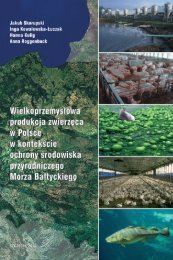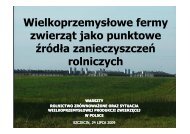best available technologies for manure treatment - Baltic Green Belt
best available technologies for manure treatment - Baltic Green Belt
best available technologies for manure treatment - Baltic Green Belt
Create successful ePaper yourself
Turn your PDF publications into a flip-book with our unique Google optimized e-Paper software.
Best Available Technologies <strong>for</strong> <strong>manure</strong> <strong>treatment</strong> baltic sea 2020<br />
Best Available Technologies <strong>for</strong> <strong>manure</strong> <strong>treatment</strong> baltic sea 2020<br />
ANNEX E: TABLES WITH SHORT DESPRIPTION OF LIVESTOCK MANURE TREATMENT TECHNOLOGIES<br />
Best Available Techniques <strong>for</strong> <strong>manure</strong> <strong>treatment</strong> - <strong>for</strong> intensive rearing of pigs in <strong>Baltic</strong> Sea Region EU Member States Technical Report "Best Practice Manure Handling, Phase 2"<br />
Ref No. 22 PH increasing, liming<br />
Brief description<br />
Description of the effect on leaching (positive or<br />
negative) of N and P<br />
It is in some cases relevant to increase the pH in the <strong>manure</strong> substrate. This is <strong>for</strong> instance the case in connection<br />
with N-stripping – see below.<br />
A Swedish company has described a concept whereby livestock <strong>manure</strong> with more than 50% dry matter undergoes<br />
a drying and sterilization process, where only energy generated by calcium oxide hydration process is used. As a<br />
reagent is used very high reactivity lime oxide. The product becomes a soil liming fertiliser in a dry sterilized <strong>for</strong>m.<br />
The reactive lime used in the process is serving as a source of energy <strong>for</strong> the drying and as sterilizing agent <strong>for</strong> all<br />
bacteria and viruses (pathogens) present in the <strong>manure</strong>, and as liming agent changing soil pH.<br />
Probably no effect in case of N-stripping, which as<br />
mentioned typically is done to avoid anaerobic<br />
digestion inhibition.<br />
The effect connected with the use of lime <strong>for</strong> drying<br />
the <strong>manure</strong> will make it more economic to transport<br />
the <strong>manure</strong> to other areas – however, pig <strong>manure</strong>s are<br />
almost always in the <strong>for</strong>m of slurry, <strong>for</strong> which the<br />
technology apparently is not relevant.<br />
Innovation stage<br />
Investment price, <br />
Basic Variable<br />
Operational costs,<br />
per tonnes<br />
per kg<br />
saved N or<br />
P leaching<br />
Complexity of implementation<br />
Research <br />
Pilot<br />
No data No data No data<br />
Practice<br />
Major references<br />
Condition <strong>for</strong> leaching<br />
reduction effect<br />
Certainty of in<strong>for</strong>mation<br />
No data<br />
Low – mixing of the <strong>manure</strong> with lime can probably<br />
be done with machinery that is <strong>available</strong> on most<br />
farms.<br />
Knut Hovland Scenarios II to V<br />
Prices None<br />
Effect on leaching Low<br />
57<br />
Side 58<br />
57








